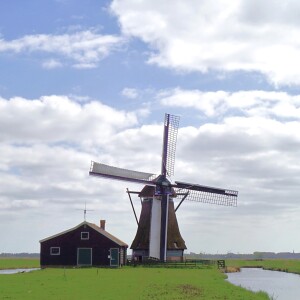Windmill 'De Zwarte Hengst', Wormer
'Zwarte' = 'zwar-tuh'
'De Zwarte Hengst' = 'The Black Stud' (as in horses)
Main shot -- portrait / Extra -- landscape
Weather-wise, a risky drive to the north, but, as usual, I thought I would go for it. The weather is often grey at the moment, sunny patches notwithstanding.
The Black Stud was 'born' in 1866. The very first windmill on this spot, though, was built as early as 1592 and rebuilt in 1654 and 1679. That last one burned down in 1840 and was replaced by a mill of another type, which, in turn, was hit by lightning and razed to the ground early in 1866, and this one replaced that and has been here since. This one, though, was not built here but moved to this spot from nearby Zaandijk, where it apparently functioned as a paper mill. While it was registered on this spot in 1866, it was originally built in 1679. The registration had to be changed when its function changed -- from papermill to cornmill, which is what it is today. It originally had another name -- 'Arme Jacob', or 'Poor Jacob'. No one knows where that came from.
The municipality of Wormerland (nothing to do with worms, or does it?) is part of the local region called the Zaan (where we get the Dutch 'zand', which led to the English 'sand'), a very sandy area in prehistory, when only half of the country was above water and this area was completely under. I believe that when Doggerland in the North Sea disappeared under the waves, a lot of water flowed away through the millennia and eventually, in our modern time, it became a lot easier to reclaim land here and turn it into polders by the time it was settled by humans.
The Zaan and Wormer polders eventually turned into some kind of windmill powerhouse factories, where thousands of mills were built to support the shipbuilding industry, which led to the Dutch Golden Age of sea exploration, during which it was more than possible to build one ship a month or even less. Even the Russian Tsar Peter the Great spent his apprenticeship years in this area. Can you imagine hundreds of mills in rows sawing and cutting logs night and day and one ship after another being put to water, the Dutch fleet never running out? (I've compressed the various millennia into a few sentences but I hope I wasn't too vague.)
Some traffic going there, a lot more on the way back. I didn't leave earlier due to the weather. Back home, finished cleaning my study, a good feeling whenever I do that. After dinner, Beau picked up AW for their usual Thursday evening bridge.
Thankful for a full day and for some sun.


Comments
Sign in or get an account to comment.


